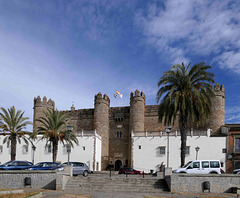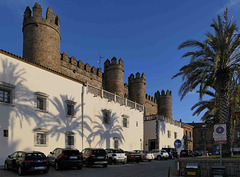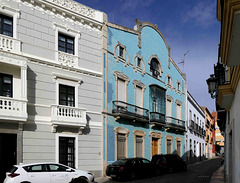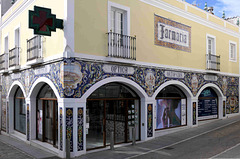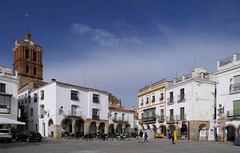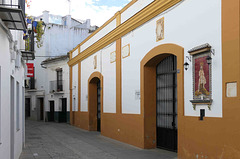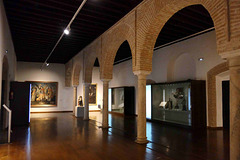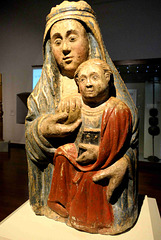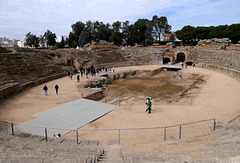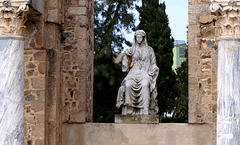
Extremadura
Zafra - Palacio de los Duques de Feria
| |
|
|
In ancient times, Zafra was located on the Via de la Plata, a road fortified by the Romans between Hispalis (Seville) and Asturica Augusta (Astorga). There are ruins of several Roman estates in the area. In the early 8th century the region was taken by the Moors, whose rule under the Umayyads, Almoravids, and Almohads lasted until the 13th century.
During the Reconquista, Zafra was captured twice, first in 1229 by Alfonso IX, and then in 1241 definitively by Ferdinand III. The area was then repopulated ("repoblación") by settlers from the north of the peninsula. In 1394, Henry III handed over the towns of Feria and Zafra to Gómez Suárez de Figueroa, the Grand Master of the Order of Santiago.
Lorenzo II Suárez de Figueroa, II Lord and I Count of Feria, ordered the construction of the fortress in 1437. The idea was to both build a new residence commensurate with his rank and to complete the city's urban defenses. The construction took place in just six years.
Over the last centuries, the palace suffered a long decline and was used as a prison, a hospital, and a high school until work began in 1965 to turn it into a Parador de Turismo.
Zafra - Palacio de los Duques de Feria
| |
|
|
In ancient times, Zafra was located on the Via de la Plata, a road fortified by the Romans between Hispalis (Seville) and Asturica Augusta (Astorga). There are ruins of several Roman estates in the area. In the early 8th century the region was taken by the Moors, whose rule under the Umayyads, Almoravids, and Almohads lasted until the 13th century.
During the Reconquista, Zafra was captured twice, first in 1229 by Alfonso IX, and then in 1241 definitively by Ferdinand III. The area was then repopulated ("repoblación") by settlers from the north of the peninsula. In 1394, Henry III handed over the towns of Feria and Zafra to Gómez Suárez de Figueroa, the Grand Master of the Order of Santiago.
Lorenzo II Suárez de Figueroa, II Lord and I Count of Feria, ordered the construction of the fortress in 1437. The idea was to both build a new residence commensurate with his rank and to complete the city's urban defenses. The construction took place in just six years.
Over the last centuries, the palace suffered a long decline and was used as a prison, a hospital, and a high school until work began in 1965 to turn it into a Parador de Turismo.
Zafra - Via de la Plata
| |
|
|
In ancient times, Zafra was located on the Via de la Plata, a road fortified by the Romans between Hispalis (Seville) and Asturica Augusta (Astorga). There are ruins of several Roman estates in the area. In the early 8th century the region was taken by the Moors, whose rule under the Umayyads, Almoravids, and Almohads lasted until the 13th century.
During the Reconquista, Zafra was captured twice, first in 1229 by Alfonso IX, and then in 1241 definitively by Ferdinand III. The area was then repopulated ("repoblación") by settlers from the north of the peninsula. In 1394, Henry III handed over the towns of Feria and Zafra to Gómez Suárez de Figueroa, the Grand Master of the Order of Santiago.
The "Via de la Plata", one of the many Caminos to Santiago runs through Zafra.
Zafra
| |
|
|
In ancient times, Zafra was located on the Via de la Plata, a road fortified by the Romans between Hispalis (Seville) and Asturica Augusta (Astorga). There are ruins of several Roman estates in the area. In the early 8th century the region was taken by the Moors, whose rule under the Umayyads, Almoravids, and Almohads lasted until the 13th century.
During the Reconquista, Zafra was captured twice, first in 1229 by Alfonso IX, and then in 1241 definitively by Ferdinand III. The area was then repopulated ("repoblación") by settlers from the north of the peninsula. In 1394, Henry III handed over the towns of Feria and Zafra to Gómez Suárez de Figueroa, the Grand Master of the Order of Santiago.
Zafra - Farmacia Buzo
| |
|
|
In ancient times, Zafra was located on the Via de la Plata, a road fortified by the Romans between Hispalis (Seville) and Asturica Augusta (Astorga). There are ruins of several Roman estates in the area. In the early 8th century the region was taken by the Moors, whose rule under the Umayyads, Almoravids, and Almohads lasted until the 13th century.
During the Reconquista, Zafra was captured twice, first in 1229 by Alfonso IX, and then in 1241 definitively by Ferdinand III. The area was then repopulated ("repoblación") by settlers from the north of the peninsula. In 1394, Henry III handed over the towns of Feria and Zafra to Gómez Suárez de Figueroa, the Grand Master of the Order of Santiago.
Farmacia Buzo is one of the old farmacies in Zafra.
Zafra - Plaza Grande
| |
|
|
In ancient times, Zafra was located on the Via de la Plata, a road fortified by the Romans between Hispalis (Seville) and Asturica Augusta (Astorga). There are ruins of several Roman estates in the area. In the early 8th century the region was taken by the Moors, whose rule under the Umayyads, Almoravids, and Almohads lasted until the 13th century.
During the Reconquista, Zafra was captured twice, first in 1229 by Alfonso IX, and then in 1241 definitively by Ferdinand III. The area was then repopulated ("repoblación") by settlers from the north of the peninsula. In 1394, Henry III handed over the towns of Feria and Zafra to Gómez Suárez de Figueroa, the Grand Master of the Order of Santiago.
The “Plaza Grande” is the largest square in Zafra. It was created in the 16th century when the medieval church on this site was demolished and the cemetery there was abandoned.
Zafra - Santa María de la Candelaria
| |
|
|
In ancient times, Zafra was located on the Via de la Plata, a road fortified by the Romans between Hispalis (Seville) and Asturica Augusta (Astorga). There are ruins of several Roman estates in the area. In the early 8th century the region was taken by the Moors, whose rule under the Umayyads, Almoravids, and Almohads lasted until the 13th century.
During the Reconquista, Zafra was captured twice, first in 1229 by Alfonso IX, and then in 1241 definitively by Ferdinand III. The area was then repopulated ("repoblación") by settlers from the north of the peninsula. In 1394, Henry III handed over the towns of Feria and Zafra to Gómez Suárez de Figueroa, the Grand Master of the Order of Santiago.
The tower of Santa María de la Candelaria, seen from the Plaza Grande.
Until the mid-16th century, the original church of Santa María de la Candelaria, along with its attached cemetery, stood in the current Plaza Grande. Count Gomes II Suárez de Figueroa then asked Pope Alexander VI. for a bull to convert the old synagogue, which had already been converted into a church, into a parish seat, a bull which he received in 1500.
Zafra - Mercado de Abastos
| |
|
|
In ancient times, Zafra was located on the Via de la Plata, a road fortified by the Romans between Hispalis (Seville) and Asturica Augusta (Astorga). There are ruins of several Roman estates in the area. In the early 8th century the region was taken by the Moors, whose rule under the Umayyads, Almoravids, and Almohads lasted until the 13th century.
During the Reconquista, Zafra was captured twice, first in 1229 by Alfonso IX, and then in 1241 definitively by Ferdinand III. The area was then repopulated ("repoblación") by settlers from the north of the peninsula. In 1394, Henry III handed over the towns of Feria and Zafra to Gómez Suárez de Figueroa, the Grand Master of the Order of Santiago.
It may look like the entrance to a convent, but this is the "Mercado de Abastos", the covered market.
Zafra - Convento de Santa Clara
| |
|
|
In ancient times, Zafra was located on the Via de la Plata, a road fortified by the Romans between Hispalis (Seville) and Asturica Augusta (Astorga). There are ruins of several Roman estates in the area. In the early 8th century the region was taken by the Moors, whose rule under the Umayyads, Almoravids, and Almohads lasted until the 13th century.
During the Reconquista, Zafra was captured twice, first in 1229 by Alfonso IX, and then in 1241 definitively by Ferdinand III. The area was then repopulated ("repoblación") by settlers from the north of the peninsula. In 1394, Henry III handed over the towns of Feria and Zafra to Gómez Suárez de Figueroa, the Grand Master of the Order of Santiago.
The monastery was founded in 1431. Today nuns still live here and offer excellent pastries in a small shop. In addition, they run a small museum.
Originally, the nuns' church was the burial place of the House of Feria, but the building was heavily rebuilt and renovated in the 17th century.
Zafra - Museo Santa Clara
| |
|
|
In ancient times, Zafra was located on the Via de la Plata, a road fortified by the Romans between Hispalis (Seville) and Asturica Augusta (Astorga). There are ruins of several Roman estates in the area. In the early 8th century the region was taken by the Moors, whose rule under the Umayyads, Almoravids, and Almohads lasted until the 13th century.
During the Reconquista, Zafra was captured twice, first in 1229 by Alfonso IX, and then in 1241 definitively by Ferdinand III. The area was then repopulated ("repoblación") by settlers from the north of the peninsula. In 1394, Henry III handed over the towns of Feria and Zafra to Gómez Suárez de Figueroa, the Grand Master of the Order of Santiago.
The Convento de Santa Clara was founded in 1431. Today nuns still live here and offer excellent pastries in a small shop. In addition, they run the Museo Santa Clara
Zafra - Museo Santa Clara
| |
|
|
In ancient times, Zafra was located on the Via de la Plata, a road fortified by the Romans between Hispalis (Seville) and Asturica Augusta (Astorga). There are ruins of several Roman estates in the area. In the early 8th century the region was taken by the Moors, whose rule under the Umayyads, Almoravids, and Almohads lasted until the 13th century.
During the Reconquista, Zafra was captured twice, first in 1229 by Alfonso IX, and then in 1241 definitively by Ferdinand III. The area was then repopulated ("repoblación") by settlers from the north of the peninsula. In 1394, Henry III handed over the towns of Feria and Zafra to Gómez Suárez de Figueroa, the Grand Master of the Order of Santiago.
The Convento de Santa Clara was founded in 1431. Today nuns still live here and offer excellent pastries in a small shop. In addition, they run the Museo Santa Clara
Virgo de la Aurora / Our Lady of Dawn / early 15th c.
Merida - Plaza de Toros
| |
|
|
In the Roman Empire, the city was known as "Emerita Augusta", the capital of the province of Lusitania. It was founded in 25 BC by Emperor Augustus as a colony for the veteran soldiers ("emeritus") of the Roman legions. The city was very important in Roman Hispania. It was endowed with all the comforts of a large Roman city and served as the capital of the Roman province of Lusitania. For centuries, until the fall of the Roman Empire, Mérida was an important economic, military, and cultural center.
Following invasions from the Visigoths, Mérida remained an important city of the Visigothic Kingdom of Hispania in the 6th century. In 713, the Arabs conquered the city and devastated it. Even under Islamic rule, Mérida remained a bishop's seat until it was moved to Santiago de Compostela in 1119.
In 1230 the Christian troops under Alfonso IX conquered Mérida during the Reconquista.
Mérida has a long bullfighting tradition, linked primarily to bullfights organized by brotherhoods, such as the bullfight organized in 1460 by the Brotherhood of San Gregorio Ostiense, patron saint against plagues of locusts.
Construction of the bullring began in 1902 but continued until the 1920s. During the Spanish Civil War, the bullring was opened in 1939 as part of the city's Franco concentration camp, which was intended to house a total of 9,000 internees.
Merida - Plaza de España
| |
|
|
In the Roman Empire, the city was known as "Emerita Augusta", the capital of the province of Lusitania. It was founded in 25 BC by Emperor Augustus as a colony for the veteran soldiers ("emeritus") of the Roman legions. The city was very important in Roman Hispania. It was endowed with all the comforts of a large Roman city and served as the capital of the Roman province of Lusitania. For centuries, until the fall of the Roman Empire, Mérida was an important economic, military, and cultural center.
Following invasions from the Visigoths, Mérida remained an important city of the Visigothic Kingdom of Hispania in the 6th century. In 713, the Arabs conquered the city and devastated it. Even under Islamic rule, Mérida remained a bishop's seat until it was moved to Santiago de Compostela in 1119.
In 1230 the Christian troops under Alfonso IX conquered Mérida during the Reconquista.
This square has been a marketplace since its founding during the time of the Catholic Monarchs. It was also used as an arena for corridas, a place for executions and processions. Government buildings have been built on this large rectangular square since the beginning of modern times until today.
There is a relaxed atmosphere here today. While the children ride the carousel, parents or grandparents drink coffee or wine.
Merida - Anfiteatro
| |
|
|
In the Roman Empire, the city was known as "Emerita Augusta", the capital of the province of Lusitania. It was founded in 25 BC by Emperor Augustus as a colony for the veteran soldiers ("emeritus") of the Roman legions. The city was very important in Roman Hispania. It was endowed with all the comforts of a large Roman city and served as the capital of the Roman province of Lusitania. For centuries, until the fall of the Roman Empire, Mérida was an important economic, military, and cultural center.
Following invasions from the Visigoths, Mérida remained an important city of the Visigothic Kingdom of Hispania in the 6th century. In 713, the Arabs conquered the city and devastated it. Even under Islamic rule, Mérida remained a bishop's seat until it was moved to Santiago de Compostela in 1119.
In 1230 the Christian troops under Alfonso IX conquered Mérida during the Reconquista.
The "Anfiteatro de Mérida" is a ruined Roman amphitheater. Emerita Augusta, was founded in 25 BC the amphitheatre itself was completed in 8 BC. The building was intended for gladiatorial fights and combats between beasts or men and beasts. The stands had a capacity of approximately 15,000 spectators.
The amphitheater is part of the Archaeological Ensemble of Mérida, which is one of the most extensive archaeological sites in Spain. It was declared a World Heritage Site by UNESCO in 1993.
Merida - Teatro romano
| |
|
|
In the Roman Empire, the city was known as "Emerita Augusta", the capital of the province of Lusitania. It was founded in 25 BC by Emperor Augustus as a colony for the veteran soldiers ("emeritus") of the Roman legions. The city was very important in Roman Hispania. It was endowed with all the comforts of a large Roman city and served as the capital of the Roman province of Lusitania. For centuries, until the fall of the Roman Empire, Mérida was an important economic, military, and cultural center.
Following invasions from the Visigoths, Mérida remained an important city of the Visigothic Kingdom of Hispania in the 6th century. In 713, the Arabs conquered the city and devastated it. Even under Islamic rule, Mérida remained a bishop's seat until it was moved to Santiago de Compostela in 1119.
In 1230 the Christian troops under Alfonso IX conquered Mérida during the Reconquista.
The "Teatro romano de Mérida" was constructed in the years 16 to 15 BCE. It has undergone several renovations, notably at the end of the 1st century or early 2nd century CE when the current facade was erected, and another at the time of Constantine I, which introduced new decorative-architectural elements and a walkway around the monument. Following the theatre's abandonment in Late Antiquity, it was slowly covered with earth.
In its time it had a seating capacity of 6,000. The diameter is about 86 meters.
Merida - Teatro romano
| |
|
|
In the Roman Empire, the city was known as "Emerita Augusta", the capital of the province of Lusitania. It was founded in 25 BC by Emperor Augustus as a colony for the veteran soldiers ("emeritus") of the Roman legions. The city was very important in Roman Hispania. It was endowed with all the comforts of a large Roman city and served as the capital of the Roman province of Lusitania. For centuries, until the fall of the Roman Empire, Mérida was an important economic, military, and cultural center.
Following invasions from the Visigoths, Mérida remained an important city of the Visigothic Kingdom of Hispania in the 6th century. In 713, the Arabs conquered the city and devastated it. Even under Islamic rule, Mérida remained a bishop's seat until it was moved to Santiago de Compostela in 1119.
In 1230 the Christian troops under Alfonso IX conquered Mérida during the Reconquista.
The "Teatro romano de Mérida" was constructed in the years 16 to 15 BCE. It has undergone several renovations, notably at the end of the 1st century or early 2nd century CE when the current facade was erected, and another at the time of Constantine I, which introduced new decorative-architectural elements and a walkway around the monument. Following the theatre's abandonment in Late Antiquity, it was slowly covered with earth. In its time it had a seating capacity of 6,000. The diameter is about 86 meters.
She is watching the scene since 2000 years.
Merida - Teatro romano
| |
|
|
In the Roman Empire, the city was known as "Emerita Augusta", the capital of the province of Lusitania. It was founded in 25 BC by Emperor Augustus as a colony for the veteran soldiers ("emeritus") of the Roman legions. The city was very important in Roman Hispania. It was endowed with all the comforts of a large Roman city and served as the capital of the Roman province of Lusitania. For centuries, until the fall of the Roman Empire, Mérida was an important economic, military, and cultural center.
Following invasions from the Visigoths, Mérida remained an important city of the Visigothic Kingdom of Hispania in the 6th century. In 713, the Arabs conquered the city and devastated it. Even under Islamic rule, Mérida remained a bishop's seat until it was moved to Santiago de Compostela in 1119.
In 1230 the Christian troops under Alfonso IX conquered Mérida during the Reconquista.
The "Teatro romano de Mérida" was constructed in the years 16 to 15 BCE. It has undergone several renovations, notably at the end of the 1st century or early 2nd century CE when the current facade was erected, and another at the time of Constantine I, which introduced new decorative-architectural elements and a walkway around the monument. Following the theatre's abandonment in Late Antiquity, it was slowly covered with earth. In its time it had a seating capacity of 6,000. The diameter is about 86 meters.
Merida - Plaza de España
| |
|
|
In the Roman Empire, the city was known as "Emerita Augusta", the capital of the province of Lusitania. It was founded in 25 BC by Emperor Augustus as a colony for the veteran soldiers ("emeritus") of the Roman legions. The city was very important in Roman Hispania. It was endowed with all the comforts of a large Roman city and served as the capital of the Roman province of Lusitania. For centuries, until the fall of the Roman Empire, Mérida was an important economic, military, and cultural center.
Following invasions from the Visigoths, Mérida remained an important city of the Visigothic Kingdom of Hispania in the 6th century. In 713, the Arabs conquered the city and devastated it. Even under Islamic rule, Mérida remained a bishop's seat until it was moved to Santiago de Compostela in 1119.
In 1230 the Christian troops under Alfonso IX conquered Mérida during the Reconquista.
This formerly very prestigious house on the Plaza de España had obviously been scaffolded for a long time. There had been a Chinese store here a long time ago. Some azulejos were still to be found.
Just found out that the building once was called "Palacio de la China"
Jump to top
RSS feed- Latest items - Subscribe to the latest items added to this album
- ipernity © 2007-2024
- Help & Contact
|
Club news
|
About ipernity
|
History |
ipernity Club & Prices |
Guide of good conduct
Donate | Group guidelines | Privacy policy | Terms of use | Statutes | In memoria -
Facebook
Twitter

